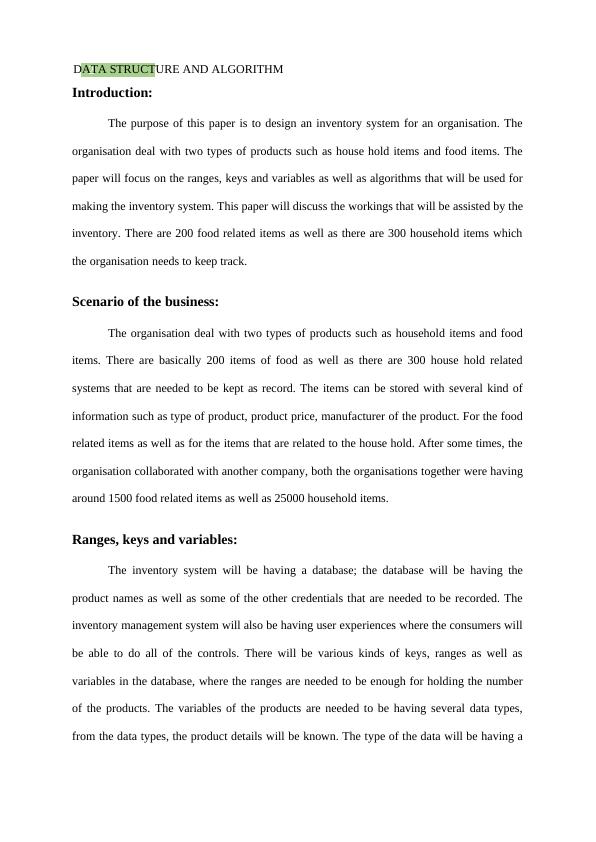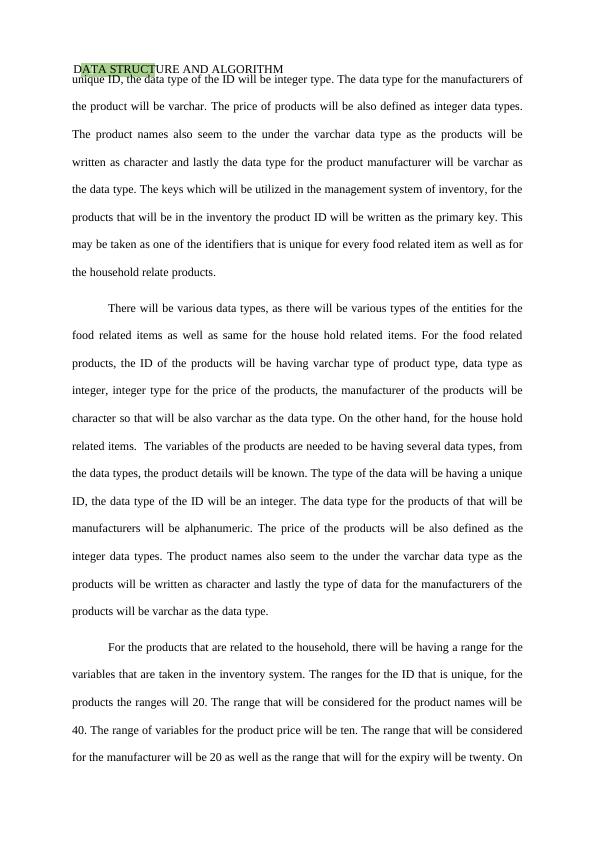Algorithms for the Inventory Management System
The assessment requires the design of an OOP system using Data Structures and Algorithms.
11 Pages2691 Words13 Views
Added on 2022-10-13
Algorithms for the Inventory Management System
The assessment requires the design of an OOP system using Data Structures and Algorithms.
Added on 2022-10-13
ShareRelated Documents
Running head: DATA STRUCTURE AND ALGORITHM
DATA STRUCTURE AND ALGORITHM
Name of the Student
Name of the University
Author Note
DATA STRUCTURE AND ALGORITHM
Name of the Student
Name of the University
Author Note

1DATA STRUCTURE AND ALGORITHM
Table of Contents
Introduction:...............................................................................................................................2
Scenario of the business:............................................................................................................2
Ranges, keys and variables:.......................................................................................................2
Operations needed in the Inventory management:.....................................................................4
The algorithms that are needed for the operations:....................................................................5
Changes needed for the inventory management system:...........................................................7
Conclusion:................................................................................................................................7
Bibliography:..............................................................................................................................8
Table of Contents
Introduction:...............................................................................................................................2
Scenario of the business:............................................................................................................2
Ranges, keys and variables:.......................................................................................................2
Operations needed in the Inventory management:.....................................................................4
The algorithms that are needed for the operations:....................................................................5
Changes needed for the inventory management system:...........................................................7
Conclusion:................................................................................................................................7
Bibliography:..............................................................................................................................8

2DATA STRUCTURE AND ALGORITHM
Introduction:
The purpose of this paper is to design an inventory system for an organisation. The
organisation deal with two types of products such as house hold items and food items. The
paper will focus on the ranges, keys and variables as well as algorithms that will be used for
making the inventory system. This paper will discuss the workings that will be assisted by the
inventory. There are 200 food related items as well as there are 300 household items which
the organisation needs to keep track.
Scenario of the business:
The organisation deal with two types of products such as household items and food
items. There are basically 200 items of food as well as there are 300 house hold related
systems that are needed to be kept as record. The items can be stored with several kind of
information such as type of product, product price, manufacturer of the product. For the food
related items as well as for the items that are related to the house hold. After some times, the
organisation collaborated with another company, both the organisations together were having
around 1500 food related items as well as 25000 household items.
Ranges, keys and variables:
The inventory system will be having a database; the database will be having the
product names as well as some of the other credentials that are needed to be recorded. The
inventory management system will also be having user experiences where the consumers will
be able to do all of the controls. There will be various kinds of keys, ranges as well as
variables in the database, where the ranges are needed to be enough for holding the number
of the products. The variables of the products are needed to be having several data types,
from the data types, the product details will be known. The type of the data will be having a
Introduction:
The purpose of this paper is to design an inventory system for an organisation. The
organisation deal with two types of products such as house hold items and food items. The
paper will focus on the ranges, keys and variables as well as algorithms that will be used for
making the inventory system. This paper will discuss the workings that will be assisted by the
inventory. There are 200 food related items as well as there are 300 household items which
the organisation needs to keep track.
Scenario of the business:
The organisation deal with two types of products such as household items and food
items. There are basically 200 items of food as well as there are 300 house hold related
systems that are needed to be kept as record. The items can be stored with several kind of
information such as type of product, product price, manufacturer of the product. For the food
related items as well as for the items that are related to the house hold. After some times, the
organisation collaborated with another company, both the organisations together were having
around 1500 food related items as well as 25000 household items.
Ranges, keys and variables:
The inventory system will be having a database; the database will be having the
product names as well as some of the other credentials that are needed to be recorded. The
inventory management system will also be having user experiences where the consumers will
be able to do all of the controls. There will be various kinds of keys, ranges as well as
variables in the database, where the ranges are needed to be enough for holding the number
of the products. The variables of the products are needed to be having several data types,
from the data types, the product details will be known. The type of the data will be having a

3DATA STRUCTURE AND ALGORITHM
unique ID, the data type of the ID will be integer type. The data type for the manufacturers of
the product will be varchar. The price of products will be also defined as integer data types.
The product names also seem to the under the varchar data type as the products will be
written as character and lastly the data type for the product manufacturer will be varchar as
the data type. The keys which will be utilized in the management system of inventory, for the
products that will be in the inventory the product ID will be written as the primary key. This
may be taken as one of the identifiers that is unique for every food related item as well as for
the household relate products.
There will be various data types, as there will be various types of the entities for the
food related items as well as same for the house hold related items. For the food related
products, the ID of the products will be having varchar type of product type, data type as
integer, integer type for the price of the products, the manufacturer of the products will be
character so that will be also varchar as the data type. On the other hand, for the house hold
related items. The variables of the products are needed to be having several data types, from
the data types, the product details will be known. The type of the data will be having a unique
ID, the data type of the ID will be an integer. The data type for the products of that will be
manufacturers will be alphanumeric. The price of the products will be also defined as the
integer data types. The product names also seem to the under the varchar data type as the
products will be written as character and lastly the type of data for the manufacturers of the
products will be varchar as the data type.
For the products that are related to the household, there will be having a range for the
variables that are taken in the inventory system. The ranges for the ID that is unique, for the
products the ranges will 20. The range that will be considered for the product names will be
40. The range of variables for the product price will be ten. The range that will be considered
for the manufacturer will be 20 as well as the range that will for the expiry will be twenty. On
unique ID, the data type of the ID will be integer type. The data type for the manufacturers of
the product will be varchar. The price of products will be also defined as integer data types.
The product names also seem to the under the varchar data type as the products will be
written as character and lastly the data type for the product manufacturer will be varchar as
the data type. The keys which will be utilized in the management system of inventory, for the
products that will be in the inventory the product ID will be written as the primary key. This
may be taken as one of the identifiers that is unique for every food related item as well as for
the household relate products.
There will be various data types, as there will be various types of the entities for the
food related items as well as same for the house hold related items. For the food related
products, the ID of the products will be having varchar type of product type, data type as
integer, integer type for the price of the products, the manufacturer of the products will be
character so that will be also varchar as the data type. On the other hand, for the house hold
related items. The variables of the products are needed to be having several data types, from
the data types, the product details will be known. The type of the data will be having a unique
ID, the data type of the ID will be an integer. The data type for the products of that will be
manufacturers will be alphanumeric. The price of the products will be also defined as the
integer data types. The product names also seem to the under the varchar data type as the
products will be written as character and lastly the type of data for the manufacturers of the
products will be varchar as the data type.
For the products that are related to the household, there will be having a range for the
variables that are taken in the inventory system. The ranges for the ID that is unique, for the
products the ranges will 20. The range that will be considered for the product names will be
40. The range of variables for the product price will be ten. The range that will be considered
for the manufacturer will be 20 as well as the range that will for the expiry will be twenty. On

End of preview
Want to access all the pages? Upload your documents or become a member.
Related Documents
Data Structure and Algorithms for Inventory Systemlg...
|13
|2620
|389
Designing an Inventory System: Variables, Keys, Ranges, Operations, and Algorithmslg...
|13
|2800
|337
Data Structure and Algorithms Australia Report 2022lg...
|17
|2852
|12
Data Structures and Algorithms Report 2022lg...
|11
|2568
|8
Data Structure and Algorithm for Inventory Systemslg...
|17
|3245
|422
structures and algorithms Analysis 2022lg...
|9
|2461
|42
